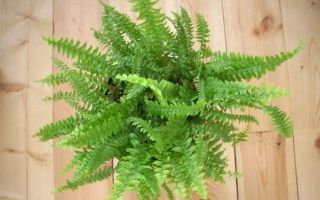Content
- 1 Description and characteristics of the fern
- 2 Fern species
- 3 What are the beneficial substances contained in the fern
- 4 Fern medicinal properties
- 5 Fern-based traditional medicine recipes
- 6 Eating ferns
- 7 Fern use on the farm
- 8 Fern signs and superstitions
- 9 Where is the best place to put the fern
- 10 Why you can't keep a fern at home
- 11 How to care for a fern
- 12 Fern harvest
- 13 Conclusion
Indoor and ornamental plants can have a serious effect on the body, so the benefits and harms of the fern are necessary to study. The domestic fern, in contrast to the tropical species, is considered hardy. Delicate plants with very small leaves have a "lacy" appearance, but this impression is deceiving due to their peculiar properties. Keeping them growing and developing indoors can be quite challenging. You also need to know all the features of their cultivation.
Description and characteristics of the fern
The domestic fern is part of the genus Adiantum, which includes more than 200 species growing around the world. The genus name comes from the Greek word adiantos, which means "unidentified."
The leaves of the plant have unique properties - they reflect water. The plant has thin, fan-shaped leaf segments that are usually grouped along tough black stems.
Ferns of this species are known to grow in areas where other plants usually do not exist. Therefore, there is an opinion that they can harm a person.
In their natural environment, they can be found on rocky walls and between rocks, where they feed on the moisture of seeping water.
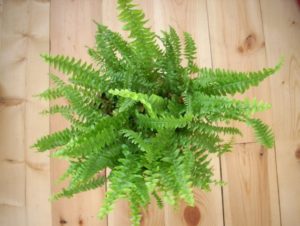
Fern species
Even with a great passion for indoor plants, few will be able to name all types of ferns: there really are a lot of them.
The following varieties are most often grown at home:
- Nephrolepis - the most voluminous indoor flower. Its leaves are bright green. They are stiff and grow upward, and then bend to the sides.
- Common ostrich - received this name because of the external resemblance to the feathers of this bird. The flower does not have any special properties and requirements, therefore it is easy to care for.
- Male shieldworm - looks like a goblet rosette. It is characterized by slow growth, spores form at the bottom of each leaf.
- Maidenhair - has the most "lacy" appearance, the most demanding for moisture. The leaves are beautifully bent at the ends, creating an openwork pattern. Outwardly, it looks like a bracken fern growing in the wild.
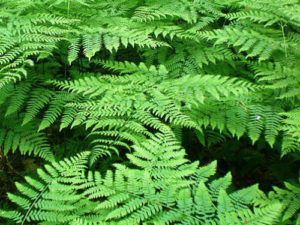
Regardless of what kind of florist wants to grow, such a plant will be a good interior decoration.
What are the beneficial substances contained in the fern
As a rule, wild-growing bracken ferns are eaten.
In terms of chemical composition, fern is an excellent source of protein, along with nuts. Other beneficial substances include fats, flavonoids, tannins, and saponins.
Young shoots of the plant contain many vitamin compounds, including riboflavin, tocopherol, nicotinic acid, and carotene.
The benefits and harms of fern for the human body are ambiguous, so it is better not to abuse this edible plant.
Fern medicinal properties
Bracken fern has been used in folk medicine since ancient times. It is considered useful in treating problems with the intestines and spleen, diarrhea, jaundice, and joint pain.
It is also used as a pain reliever, diuretic and anthelmintic. The healing properties of the fern are especially often mentioned in the fight against any parasite.
Fern-based traditional medicine recipes
In traditional folk medicine, it is believed that the medicinal properties of the fern can quickly rid the body of parasites.
For this, fern root powder is mixed with the essential extract of the plant. Then the mixture is drawn into a 2 cc syringe. see All medicine is divided into 30 servings.
The day before treatment, you should replace food with liquid: kefir, juice, etc.
On the second day, instead of breakfast, you should take one serving of the medicine every two minutes, for one hour.
Five hours after taking it, be sure to drink a spoonful of castor oil.
The medicinal properties of the fern root also lie in its benefits for varicose veins. To do this, the root of the plant is crushed into gruel, mixed with sour milk and applied to the skin. After that, you should wrap the places with the mixture with a bandage and leave for 5 - 6 hours.
Eating ferns
Bracken fern has long been eaten by the inhabitants of Japan and Korea. It is distributed as a food product in the Far East. It is currently used in a variety of ways.
The health benefits of bracken fern are attributed to its high protein and vitamin content.
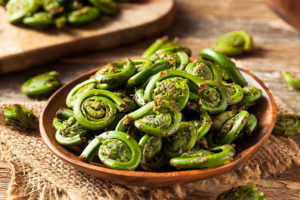
Young shoots and leaves are used to make snacks and salads. Thick stems are pickled or salted, fried or boiled. They are often used as seasonings for various dishes: the fern stems taste like mushrooms.
Fern use on the farm
Speaking about the home fern, it is worth mentioning separately the beneficial properties of the plant. Not only can it absorb dust, but it is also capable of attracting electromagnetic radiation to itself, which usually comes from various household appliances. This means that the houseplant not only improves the interior, but also benefits by clearing the space around it. This is the main useful property of the fern for the body.
The properties of the plant are also used in folk medicine. In such cases, crushed plant leaves or freshly squeezed juice are used. However, it is worthwhile to carefully study the likely benefits and harms, especially when using the product of the plant inside: most often, in this case, an edible bracken fern is used.
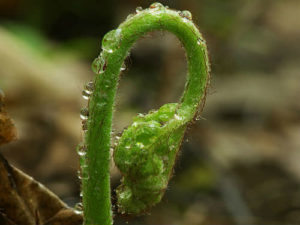
Fern harm and contraindications
Can a fern do harm? According to experts, this plant has no proven harmful properties. However, experienced flower growers recommend not to put the plant pot in the bedroom, especially next to the bed. It is also worth noting that this rule is common for all indoor flowers.
There is only one contraindication to the use of this plant - an allergic reaction, especially to spores. But this is rarely observed.
Therefore, the benefits of indoor fern clearly outweigh the potential harm.
If we talk about bracken, everything is much more complicated. Despite its use in food, it is considered a poisonous plant, especially in large quantities. It is extremely contraindicated during pregnancy.
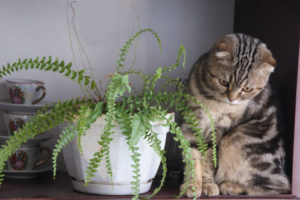
Fern signs and superstitions
The use of a fern as a home flower is judged differently by omens. Some believe that it is capable of being beneficial and generally has positive properties (for example, it helps to avoid trouble, protects the owner, and so on).
Other superstitious people argue that the plant is harmful because it attracts a lot of negativity.
What are the benefits and harms of a fern in an apartment, according to legends?
Positive
For skeptical people, the harm and health benefits of a fern by signs does not mean anything.
But some popular beliefs about the beneficial properties of the plant still deserve attention. For instance:
- The fern is able to bring harmony to the family, as it can charge the atmosphere in the house with its positive energy. All this leads to the elimination of negativity, the reconciliation of quarrels, and so on. As a result, a relationship of trust is established in the family.
- The fern will also be useful in improving relations between spouses. Most of all it is suitable for couples with different temperaments. Legends say that this plant helps people to better find compromises.
- One of the most common signs about the benefits of indoor fern is that this indoor flower can be profitable, including for gamblers.
- In general, the beneficial properties of the fern are to attract good luck to the house. But do not forget that the plant will not help in case of constant thoughtless spending.
- Signs also speak about the benefits of transplanting a flower from a pot into open ground: then it becomes a talisman. It is worth paying special attention to the owners of summer cottages.
- If a home flower suddenly began to fade, signs suggest that, protecting its owner, he absorbed the negative.
- The plant is said to be capable of fulfilling desires. However, for this you need to wait for its flowering. The flowering plant is considered especially useful on the night of Ivan Kupala. If you find it during this period and bring it home, then it will become a reliable amulet for the whole year.
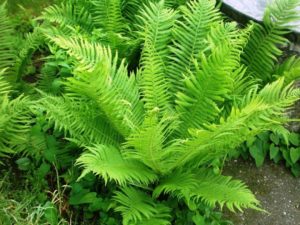
Negative
There are also stereotypes that this flower is capable of causing harm, since it carries negative energy.
What negative signs say:
- The plant can cause headaches. This opinion is quite reasonable, since harm can be caused to the owner with allergies or individual intolerance.
- It is widely believed that a fern is able to draw out negativity and illness from a person. If, after purchasing this flower, the owner begins to feel good, you should not keep the plant further in the house.
- Some signs also apply to the garden plant: crops growing next to it may begin to wither. In this case, you just need to transplant it to another territory of the summer cottage.
- There is also a sign of how to avoid possible harm from the home fern. To do this, it is best to place it in that part of the apartment where there are many electrical appliances. So the plant will begin to draw energy from them, and will not harm the owner.
Where is the best place to put the fern
These plants require certain conditions to grow indoors. Home fern needs shade. It should not be exposed to direct sunlight, and especially bright light should be avoided.
This plant requires moist, warm air. It will die or fade in dry, hot air. To achieve the correct moisture conditions, it should be sprinkled with warm water a couple of times a day. This will keep moisture on the leaves. In addition, the soil should be kept moist, but not soggy.
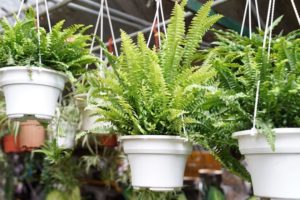
Why you can't keep a fern at home
Regarding the benefits and harms of keeping a fern at home, signs vary greatly. However, explanations of its negative properties are quite logical.
The most common esoteric opinions are as follows:
- It is believed that you can not plant a plant obtained in the forest on your site. From the point of view of esotericists, the fern has magical properties, especially in the wild. If you take a flower from its "native" place, it will start to bring trouble.
- Opinions are also divided regarding the transfer of a plant previously contained in an apartment to its site. The main reason lies in the ability of the fern to draw in energy from space. If at home the plant can feed from household appliances, in the garden it will begin to draw vitality from the crops growing nearby.
- The fern absorbs a lot of oxygen, so don't put it in your bedroom. Otherwise, it will cause harm in the form of headaches.
- If the plant is making you feel unwell, don't keep keeping it in your home. In the future, the harm from it will only increase. If this happens, the flower should be disposed of.
Since beliefs do not exclude contradictions, you should pay attention only to your well-being: if everything is good, then the plant can be considered useful. The same can be attributed to a flower in a summer cottage.
How to care for a fern
Since ferns thrive in humid environments, planting them in a pot with drainage holes is recommended. Ideally, keep the plant in a plastic container with holes, and then place it in a more attractive outer pot. This will make it easy to check the moisture level.
Drainage holes will prevent dry clods from forming. It is better to keep the plant at temperatures above 20 aboutC. Do not expose it to cold drafts or temperatures below 15 aboutC, otherwise it can harm the flower.
If necessary, fertilize with a weak liquid fertilizer twice a week, and only during the growing season, and not in the winter months. Only in this way will the plant absorb all the nutritional benefits of the fertilizer.
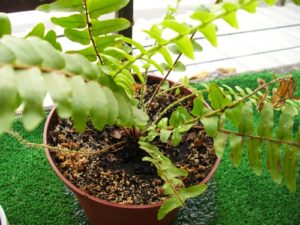
Ferns can be replanted annually or every two years, depending on pot size and growth rate. The tight container will not do them much harm. Transplanting is necessary only in cases where the roots begin to fill the pot.
In order for this process to be beneficial to the plant, a knife or shovel should be used to separate the roots. Will benefit and maintain a minimum of two to three healthy leaves in each split seedling. Each section must be planted in its own pot and ensure that they are well watered. Fertilizers cannot be used immediately, as this will harm the burning of the roots.
It should be noted that ferns are somewhat exquisite indoor plants. If the leaves curl, often fall off, and their tips are too sluggish, this indicates that the air is too dry and the plant needs more moisture. If the green leaves turn brown, this may indicate that the plant is being watered with hard water or it is receiving too much direct sunlight. Having established watering and light conditions, dry or yellowish leaves must be carefully cut off.
Fern harvest
The collection of wild-growing ferns is carried out for medical purposes. This happens in early spring or late autumn. Only the roots of the plant, which have a pistachio green color in the middle, are of value. For such a harvest, the roots are completely removed from the ground and subjected to cleaning.
Conclusion
If you know for sure what the benefits and harms of the fern are, you can safely keep this flower in the house.Speaking of the wild-growing species, it is allowed to be eaten and used for medicinal purposes only with sufficient culinary processing and some caution.

